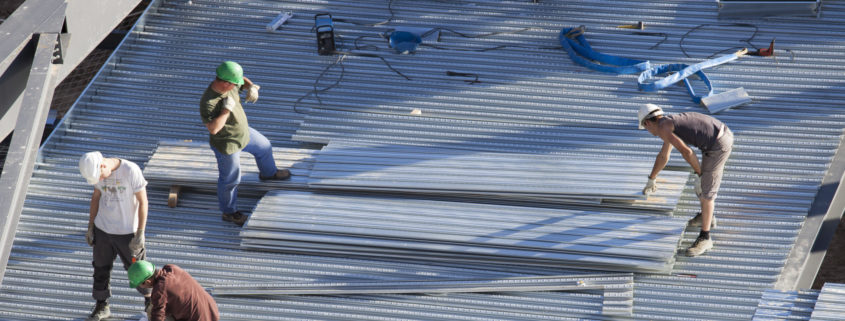The average commercial roof lasts about 20 years – but, as a business owner, do you even know how old your roof even is? Unfortunately, if your building’s roof has been around for a while, there will come a time when small repairs turn into bigger ones.
At some point, you’ll have a decision to make: repair or replace? Commercial roof repair and replacement costs vary based on the severity of the damage, so an accurate assessment of cost requires that you fully understand the problem.
There’s a lot that can go wrong with an aging roof. Here are a few examples.
Common Signs of Roof Damage
Unless you’re one of the proactive property owners who diligently schedules semi-annual roof inspections (which is industry standard), the first sign of a problem often comes from the inside. You may begin to notice water stains on ceiling tiles from problem areas on the exterior roof.
Make no mistake, these stains are very much your first red flag that bigger issues are present. Sometimes leaks show up on the walls first, but unfortunately, there’s no such thing as a “minor” leak when it comes to commercial roofs.
If you’re at the point where physical water is dripping down, you definitely need to act quickly.
If water drips onto expensive electronics, a server room or anything similar, then you could find yourself out more than the cost of roof repair (let alone a roof maintenance plan). Mold can also take a foothold quickly, especially if water is saturating the wall insulation.
All bad news and all dangerous for any commercial building!
Origins of Roof Damage
Some types of damage are not fixable while other instances may be isolated and merely a result of poor maintenance.
For example, with most commercial buildings, you’re dealing with a flat roof that is wholly dependent on good drainage. If gutters get clogged, then water will begin to pool and create a vulnerability that wasn’t previously known. Even roofs that are only a few years old can succumb to water pooling without proper maintenance.
Each square foot of standing water equals 4.3 pounds of weight per square inch. Now, multiply that by five or ten times and you have hundreds of pounds of weight bearing down on your building. This extra stress will eventually produce enough sag for water to leak down the sides or penetrate the membrane itself.
Commercial Roof Wear and Tear
It is also worth mentioning that you don’t need to experience a lot of rain in order for the roof to leak. Over time, drastic changes in temperature will create vulnerabilities in the flashing and membrane. As materials expand and contract, flashing can lose its original fitting.
Membrane materials can split and blister from years of exposure to the elements. Once the membrane gives way, water can get trapped between layers and create an environment of rot and decay. It’s only a matter of time before the membrane fails, which is why upkeep and inspections are so important.
Vents and drains on the roof are also big areas of vulnerability for a commercial roof. These openings are designed as one-way exits for air to ventilate out, but if the sealings and fittings aren’t secured, they create an easy entrance for water.
Lastly, the type of roof also plays a key role in how quickly you’ll experience these problems. PVC, TPO, EPDM and metal roofing are the most common commercial roofing options, each carrying their own pros and cons. Metal roofing, for example, has the longest lifespan out of all roofs and the least amount of maintenance if installed correctly.
Choosing Between Commercial Roof Repair and Replacement
Now that we have a general idea of everything that can go wrong, it’s time to weigh the two options. If you’re dealing with a small, isolated problem that is noticed early, repair wins. The exception, however, is when you’re nearing the end of a roof’s lifespan. When this happens, at some point, all of those little repairs will start to add up, and eventually, a full replacement will make more financial sense.
If the roof doesn’t need a new membrane and the flashing is intact, then the repair cost will remain low. If you suffered some partial damage from a storm, a repair is also likely the best choice, even if it affects more than one spot. This is because the damage will mostly remain surface-level, unlike a slow leak.
When to Get a New Roof
Extent of damage and the number of areas affected come into play here, as does the history of repairs already done to the roof.
If your roof has been through the wringer and has been habitually leaking, you need a new roof. Not only will a new roof correct the ongoing issues, but it will also give you better insulation (and, likely, better utility costs) than a commercial roof that is 20+ years old.
Ask the Commercial Roofing Experts
Ultimately, the choice between commercial roof repair and replacement will come down to cost-effectiveness. But, if you only look at the bottom-line, you could end up wasting a lot of money trying to continually repair a roof that is better off being replaced. Even more, a brand new roof could save you money on energy costs and maintenance!
If you’re still unsure which option is best for you, contact us for a free consultation. TEMA Roofing Services has decades of experience and will work to partner with you, whether you need regular maintenance, repair or full replacement.





